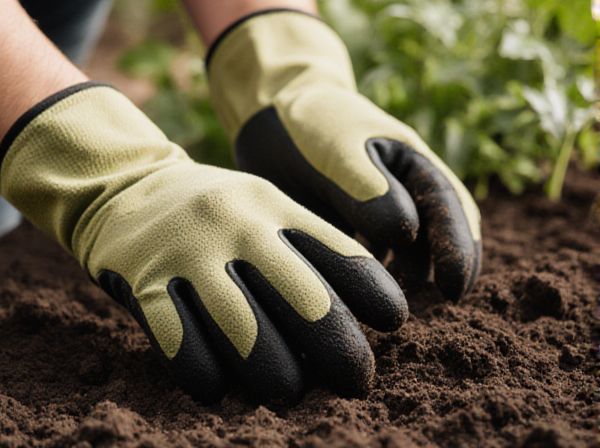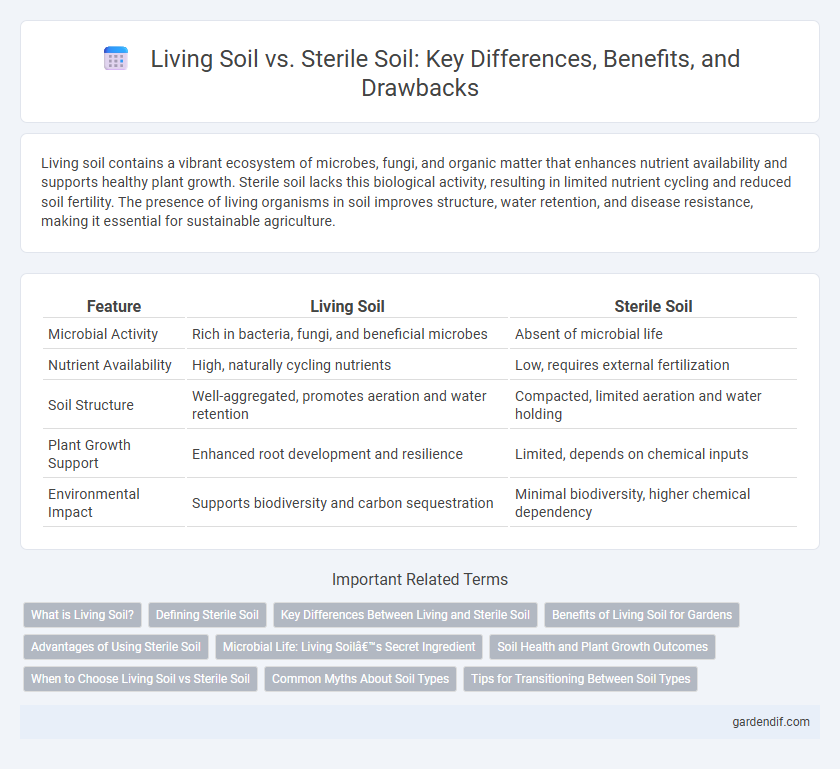
Living Soil vs Sterile Soil Illustration
Living soil contains a vibrant ecosystem of microbes, fungi, and organic matter that enhances nutrient availability and supports healthy plant growth. Sterile soil lacks this biological activity, resulting in limited nutrient cycling and reduced soil fertility. The presence of living organisms in soil improves structure, water retention, and disease resistance, making it essential for sustainable agriculture.
Table of Comparison
| Feature | Living Soil | Sterile Soil |
|---|---|---|
| Microbial Activity | Rich in bacteria, fungi, and beneficial microbes | Absent of microbial life |
| Nutrient Availability | High, naturally cycling nutrients | Low, requires external fertilization |
| Soil Structure | Well-aggregated, promotes aeration and water retention | Compacted, limited aeration and water holding |
| Plant Growth Support | Enhanced root development and resilience | Limited, depends on chemical inputs |
| Environmental Impact | Supports biodiversity and carbon sequestration | Minimal biodiversity, higher chemical dependency |
What is Living Soil?
Living soil is a rich, dynamic ecosystem teeming with microorganisms such as bacteria, fungi, protozoa, and nematodes that contribute to nutrient cycling and soil fertility. It contains organic matter, minerals, and microorganisms working symbiotically to improve soil structure, water retention, and plant health. Unlike sterile soil, living soil enhances nutrient availability and promotes natural disease suppression, supporting sustainable plant growth.
Defining Sterile Soil
Sterile soil refers to soil that has been treated to eliminate all living organisms, including bacteria, fungi, and microorganisms, resulting in a completely inert environment. This type of soil lacks the natural biological activity essential for nutrient cycling and healthy plant growth. In contrast to living soil, sterile soil requires external inputs of nutrients and microbial inoculants to support plant development.
Key Differences Between Living and Sterile Soil
Living soil contains diverse microorganisms such as bacteria, fungi, and earthworms that promote nutrient cycling, enhance soil structure, and support plant health. Sterile soil lacks this biological activity, resulting in reduced nutrient availability and soil fertility. The presence of organic matter and microbial life in living soil leads to better water retention and disease resistance compared to sterile soil.
Benefits of Living Soil for Gardens
Living soil enhances garden productivity by supporting a diverse ecosystem of beneficial microbes, fungi, and earthworms that improve nutrient cycling and soil structure. This biologically active environment promotes healthier plant root systems, increases resistance to pests and diseases, and reduces the need for chemical fertilizers. Gardens grown in living soil demonstrate better moisture retention and carbon sequestration, contributing to sustainable and resilient plant growth.
Advantages of Using Sterile Soil
Sterile soil offers a controlled environment free from pathogens, pests, and weed seeds, reducing the risk of diseases and contamination. It allows precise nutrient management and consistency in research or horticultural applications, promoting uniform plant growth. Sterile soil enhances the success rate of delicate seedlings and cuttings by minimizing microbial competition.
Microbial Life: Living Soil’s Secret Ingredient
Living soil teems with diverse microbial communities, including bacteria, fungi, and protozoa, which play essential roles in nutrient cycling and plant health. These microorganisms form symbiotic relationships with plant roots, enhancing nutrient uptake and disease resistance, unlike sterile soil that lacks this biological activity. The presence of active microbial life in living soil improves soil structure, fertility, and overall ecosystem resilience.
Soil Health and Plant Growth Outcomes
Living soil, rich in organic matter and diverse microbial communities, significantly enhances soil health by improving nutrient cycling, water retention, and disease suppression. Sterile soil lacks these beneficial microorganisms, often leading to reduced nutrient availability and poorer plant growth outcomes. Plants grown in living soil typically demonstrate increased vigor, higher yields, and greater resilience to environmental stress compared to those in sterile soil conditions.
When to Choose Living Soil vs Sterile Soil
Choose living soil when cultivating nutrient-demanding plants that benefit from active microbial communities enhancing nutrient cycling and disease suppression. Opt for sterile soil in controlled environments like seed germination or when eliminating pathogens and pests is critical to prevent crop contamination. The decision hinges on balancing biological activity needs with cleanliness to optimize plant health and yield.
Common Myths About Soil Types
Living soil is rich in organic matter and microbial communities that enhance nutrient cycling and plant health, unlike sterile soil which lacks these vital organisms and often requires synthetic inputs for fertility. Common myths include the belief that sterile soil is inherently cleaner or better for plant growth, whereas living soil fosters natural disease resistance and soil structure. Understanding the dynamic biological activity in living soil debunks misconceptions that sterilization is necessary for successful cultivation.
Tips for Transitioning Between Soil Types
Transitioning from sterile soil to living soil requires gradually introducing organic matter, such as compost or worm castings, to cultivate beneficial microorganisms and improve soil structure. Monitoring soil moisture and avoiding overwatering helps maintain microbial activity essential for living soil health. Incorporating cover crops and reducing chemical inputs further support the development of a thriving soil ecosystem during the transition.
Living Soil vs Sterile Soil Infographic

 gardendif.com
gardendif.com